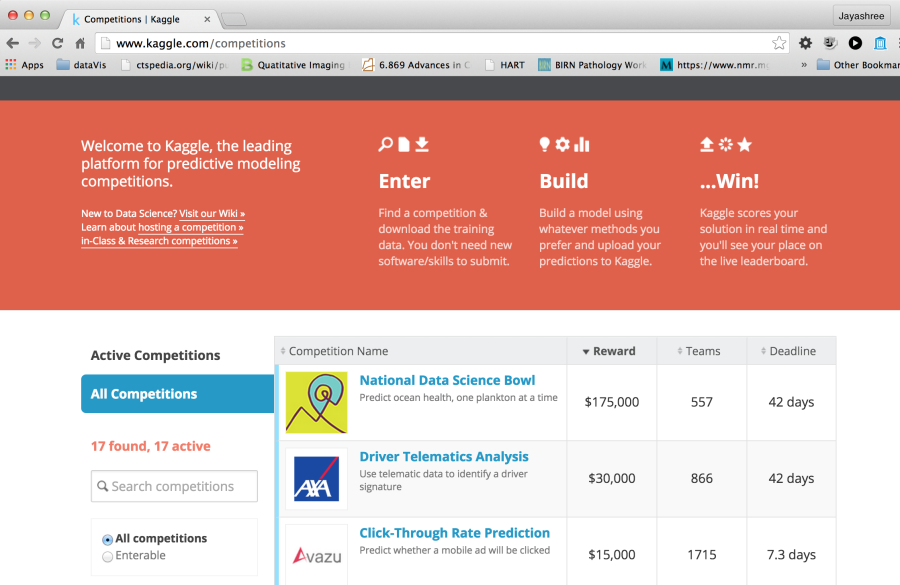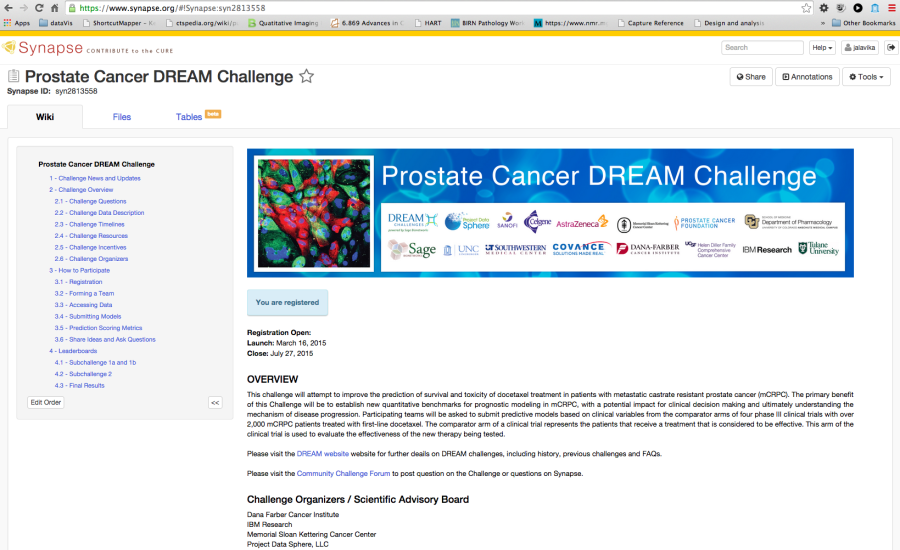 |
Page History
Infrastructure for Algorithm Comparisons, Benchmarks, and Challenges in Medical Imaging
AuthorAuthors: Jayashree Kalpathy-Cramer and Karl Helmer
...
Challenges are being increasingly viewed as a mechanism to foster advances in a number of domains, including healthcare and medicine. The United States Federal Government, as part of the open-government initiative, has underscored the role of challenges as a way to "promote innovation through collaboration and (to) harness the ingenuity of the American Public." Large quantities of publicly available data and cultural changes in the openness of science have now made it possible to use these challenges and crowdsourcing efforts to propel the field forward.
...
Some of the key advantages of challenges over conventional methods include 1) scientific rigor (sequestering the test data), 2) comparing methods on the same datasets with the same, agreed-upon metrics, 3) allowing computer scientists without access to medical data to test their methods on large clinical datasets, 4) making resources available, such as source code, and 5) bringing together diverse communities (that may traditionally not work together) of imaging and computer scientists, machine learning algorithm developers, software developers, clinicians, and biologists.
However, despite this potential, there are a number of challenges. Medical data is usually governed by privacy and security policies such as HIPPA that make it difficult to share patient data. Patient health records can be very difficult to completely de-identify. Medical imaging data, especially brain MRIs, can be particularly challenging as once one could easily reconstruct a recognizable 3D model of the subject.
...
The medical imaging community has conducted a host of challenges at conferences such as MICCAI and SPIE. However, these have typically have been modest in scope (both in terms of data size and number of participants). Medical imaging data poses additional challenges to both participants and organizers. For organizers, ensure ensuring that the data are free of PHI is both critical and non-trivial. Medical data is typically acquired in DICOM format. However, ensuring that a DICOM file is free of PHI requires domain knowledge and specialized software tools. Multimodal imaging data can be extremely large. Imaging formats for pathology images can be proprietary and interoperability between formats can require additional software development efforts. Encouraging non-imaging researchers (e.g. machine-learning scientists) to participate in imaging challenges can be difficult due to the domain knowledge required to convert medical imaging into a set of feature vectors. For participants, access to large compute clusters with computing power, storage space, and bandwidth can prove difficult. Medical imaging data is challenging for non-imaging researchers.
However, it is imperative that the imaging community develops the tools and infrastructure necessary to host these challenges and potentially enlarge the pool of methods by making it more feasible for non-imaging researchers to participate. Resources such as the Cancer Imaging Archive (TCIA) have greatly reduced the burden for sharing medical imaging data within the cancer community and making these data available for use in challenges. Although a number of challenge platforms exist currently, we are not aware of any systems that meet all the requirements necessary to currently host medical imaging challengechallenges.
In this article, we review a few historical imaging challenges. We then list the requirements we believe to be necessary (and nice to have) to support large-scale multimodal imaging challenges. We then review existing systems and develop a matrix of features and tools. Finally, we make some recommendations for developing Medical Imaging Challenge Infrastructure (MedICI), a system to support medical imaging challenges.
...
Figure 5. Portal for Kaggle, a leading website for challenges for data scientists
| Multiexcerpt include | ||||||
|---|---|---|---|---|---|---|
|
| Multiexcerpt include | ||||||
|---|---|---|---|---|---|---|
|
Open Source
| Multiexcerpt include | ||||||
|---|---|---|---|---|---|---|
|
...
Figure 7. Example Challenge hosted in Synapse
| Multiexcerpt include | ||||||
|---|---|---|---|---|---|---|
|
The main steps to create a new challenge are:
| Multiexcerpt include | ||||||
|---|---|---|---|---|---|---|
|
- Create a project
Multiexcerpt include nopanel true MultiExcerptName ExitDisclaimer PageWithExcerpt wikicontent:Exit Disclaimer to Include - Add pages
Multiexcerpt include nopanel true MultiExcerptName ExitDisclaimer PageWithExcerpt wikicontent:Exit Disclaimer to Include - Making uploaded files available for download
Multiexcerpt include nopanel true MultiExcerptName ExitDisclaimer PageWithExcerpt wikicontent:Exit Disclaimer to Include - Allowing others to register for your project
Multiexcerpt include nopanel true MultiExcerptName ExitDisclaimer PageWithExcerpt wikicontent:Exit Disclaimer to Include - Make your project appear in the projects overview
- Allow file uploads
- Including content from files on a page
Multiexcerpt include nopanel true MultiExcerptName ExitDisclaimer PageWithExcerpt wikicontent:Exit Disclaimer to Include - Allow file uploads
Multiexcerpt include nopanel true MultiExcerptName ExitDisclaimer PageWithExcerpt wikicontent:Exit Disclaimer to Include - Including content from files on a page
Multiexcerpt include nopanel true MultiExcerptName ExitDisclaimer PageWithExcerpt wikicontent:Exit Disclaimer to Include - Allow Allow others to edit the project
- Changing colors and other styling
- Project data folder
Multiexcerpt include nopanel true MultiExcerptName ExitDisclaimer PageWithExcerpt wikicontent:Exit Disclaimer to Include - Changing colors and other styling
Multiexcerpt include nopanel true MultiExcerptName ExitDisclaimer PageWithExcerpt wikicontent:Exit Disclaimer to Include - Project data folder
Multiexcerpt include nopanel true MultiExcerptName ExitDisclaimer PageWithExcerpt wikicontent:Exit Disclaimer to Include - Page permissions
Page permissionsMultiexcerpt include nopanel true MultiExcerptName ExitDisclaimer PageWithExcerpt wikicontent:Exit Disclaimer to Include
However, at this time, there is limited support for automatic evaluation of submitted results, results presentation, native support for medical images although many of these features are planned.
The HubZero
| Multiexcerpt include | ||||||
|---|---|---|---|---|---|---|
|
| Multiexcerpt include | ||||||
|---|---|---|---|---|---|---|
|
| Multiexcerpt include | ||||||
|---|---|---|---|---|---|---|
|
| Multiexcerpt include | ||||||
|---|---|---|---|---|---|---|
|
...
The MIDAS platform has been used to host a couple of imaging challenges. A special
| Multiexcerpt include | ||||||
|---|---|---|---|---|---|---|
|
...
The web portal is the single point of entry for the participants. Historically, this would have information about the challenge, potentially host the data and provide a submission site for the user to upload results. The challenge organizer could also provide the results of the challenge at this page. Many challenges have wikis and announcement pages as well as forums. A good example of active discussion forums can be found at the Kaggle
| Multiexcerpt include | ||||||
|---|---|---|---|---|---|---|
|
...

